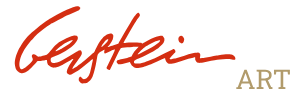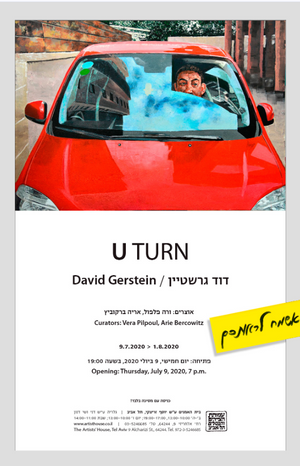David Gerstein new painting exhibition 2020 opens in Tel Aviv
Mar 07, 2020
In a turbulent time, Amidst a global pandemic raging and an economic slowdown felt everywhere, David Gerstein had found some peace and quiet to work on his latest exhibition - U-Turn.
The exhibition, which opened July 9th, 2020, features brand new large scale paintings, taking Gerstein back to his favourite themes, Cars, balconies, people.
https://www.youtube.com/watch?time_continue=228&v=ZACqv2f137k&feature=emb_logo
Here is a text written by the curators of the exhibition, Vera Pilpoul and Arie Berkowitz:
U-TURN
David Gerstein
Back to painting
The Artists’ House, Tel Aviv
David Gerstein has been formulating his artistic language over the past four decades - a humanistic language of joie de vivre and love of people, bursting out over painted surfaces and objects, becoming more refined with the years. Gerstein’s figurative paintings, mostly characterized by bold colors, contain representations of human figures moving between the local and the global, from the Middle East to the West, from the contemporary to the nostalgic. Since emerging as an artist in the 1970s, Gerstein chose to express himself in classical figurative painting. This was a conscious choice at a time that conceptual art, which had migrated from New York City to the local art scene, was not a satisfactory mode of expression for the young artist. Gerstein has always made it his practice to draw on a daily basis as part of his routine. In his scores of notebooks filled with drawings, buds of ideas are evident which matured into series of sculptures and paintings. These series were first made in the ‘80s and ‘90s during which Gerstein alternated between mediums. His constant search enabled him to develop a language which became transformed into three-dimensions -- free-standing sculptures and wall sculptures in which painting remains present while taking on spatial dimensions.
Gerstein’s body of works on view in his solo exhibition at the Tel Aviv Artists’ House brings together early paintings alongside of large-scale contemporary paintings from the past year. The exhibition displays two major series – cars and balconies – embodying Gerstein’s childhood and teenage memories. The “Balconies” series, suffused with these memories, comprises works from the ‘70s and ‘90s, focused on South Tel Aviv of those years.
The overhanging balconies of the houses that Gerstein captures express a modest, urban space lacking any aura. Here are depictions of the typical Tel Aviv balconies before the Tama 38 urban renewal, with their peeling plaster, closed wooden shutters, drawn shades that do not reveal the interior of the home, or a curtain blocking the view of the balcony from the street. After the outbreak of the current pandemic, these balconies resonate with both global and local meaning.
Gerstein’s memories also populate the second series that appears in this exhibition, combining paintings of cars made recently with others made in the 1980s. The series is a visual expression of an entirely different urban space – a European scene studded with cars. These are stationary vehicles parked on Parisian boulevards and the streets of other cities; most are empty, with a rare face peering out from a car window. The reflections of the City of Lights in the cars are dramatically portrayed in large-scale paintings made during Gerstein’s artist’s residence at the Cité de Paris from 1990-1991.
In these two series, a private, mute, and intimate space has been captured, only partially revealed to the viewer. The space that Gerstein creates operates like a sealed capsule concealing more than it is revealing. The representation of this sealed space creates a kind of “isolation chamber” for a human being in the world; the sensation becomes more intense when faced with the space of the contemporary – with its arbitrary closeness and openness – that leaves the viewer with an intense sensation of something puzzling, of being mistaken and without any ideas for a solution. This intensity is facilitated by the painted surface that expanded in time and space to provide the platform for continued research of the field of vision, so that perspective dissolves into an undefined space. As part of this study, Gerstein creates painterly collages, made from paintings of models and stencils and colorful forms through which the background is flattened and onto which concrete events are cast.
The same colorful, patterned background appearing in the exhibition together with a new icon added to the Gerstein inventory of images: the electric scooter and bicycle riders indicating contemporary urbanism at its best, characterized by restless motion, with the rapidity of the need, ability, and desire to move frequently from one point to another. This is not realism that attempts to copy reality, since the entire painting vibrates and moves with abstract gestural brushstrokes of paint and patches of color that flickers through it. And yet, this constant vibrant motion clearly refers as well to the aesthetic experience of daily life through a broad range of scenes. The color plays a part no less than the events depicted, since it constitutes part of the “melody,” part of the light and its refraction, providing expression to the emotional atmosphere.
Gerstein’s engagement with light and its refraction is made possible thanks to his frontal gaze turned on the car, similar to his direct look at the balconies. The gaze provides the inanimate car body the status of platform for optical research. Each painting freezes a moment of reflected reality around the “bubble” of the car, transforming it into a unique event rich in expression; the passage of the clouds is captured in the car’s panoramic glass; the complex distorted, spiral reflections of the architecture breaking on the car’s surface propose a multilayered, complex expression, simultaneously playfully wild and threatening.
The works continue Gerstein’s characteristic painterly line that began as far back as his studies at the Bezalel Academy of Art and Design, Jerusalem, and which he subsequently developed. His compositions are basically symmetrical; however, he disrupts the regularity of the format by cutting it. When a depiction constitutes only part of a whole, the viewer attempts to complete the Gestalt. The balconies as well as the cars are painted from a unique viewpoint that exposes large sections of the object, enabling Gerstein to apply multitude painterly treatment which frequently becomes abstract brushstrokes. This is why his paintings elude any attempt at imitating reality, but instead subverts it, attempting to create a “Gersteiny” reality based on personal, emotional and spiritual experiences.
In relation to the local art scene, we argue that Gerstein was ahead of his time in both painting and sculpture, as he mainly sought to find his own unique modes of expression and not become part of any group. The current exhibition aims to present Gerstein to a generation that has not been aware of how broad is the scope of his works and show additional viewpoints that have categorized his works as optimistic, happy, and decorative. All of these descriptions are also true, nevertheless, during the work on the exhibition we attempted to expand the commonly-accepted viewpoint referring to the “Gersteiny” language and to present the broad life’s work of David Gerstein, multidisciplinary artist, painter and sculptor.
June 2020


